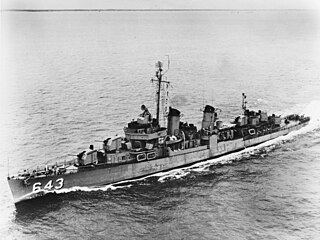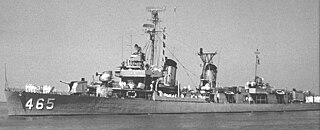
USS Mustin (DD-413) was a Sims-class destroyer of the United States Navy, the first Navy ship of that name, in honor of Captain Henry C. Mustin (1874–1923), a pioneer of naval aviation.

USS Shaw (DD-373) was a Mahan-class destroyer and the second ship of the United States Navy to be named for Captain John Shaw, a naval officer. Commissioned in 1936, Shaw was plagued by construction deficiencies and was not fully operational until 1938. After training in the Atlantic, she was transferred to the Pacific and was berthed in a dry dock in Pearl Harbor on 7 December 1941.

USS Ralph Talbot (DD-390) was a Bagley-class destroyer in the United States Navy, named for USMC Second Lieutenant Ralph Talbot (1897–1918), who was awarded the Medal of Honor during World War I. Talbot served in the Pacific Theater during World War II, from the attack on Pearl Harbor through the battle of Okinawa, earning 14 battle stars for her service.

USS Sigourney (DD-643) was a Fletcher-class destroyer, the second ship of the United States Navy to be named for James Sigourney, an officer during the War of 1812.

USS Nicholas (DD/DDE-449) was a Fletcher-class destroyer of the United States Navy, serving for a total of 27 years, including through most of World War II, the Korean War, and the Vietnam War. She was the second Navy ship to be named for Major Samuel Nicholas.

USS Saufley (DD/DDE/EDDE-465), a Fletcher-class destroyer, was a warship of the United States Navy named for pioneering Naval Aviator, Lieutenant Richard Saufley, USN.

USS Taylor (DD/DDE-468) was a Fletcher-class destroyer of the United States Navy, named for Rear Admiral William Rogers Taylor (1811–1889). She was laid down on 28 August 1941 at Bath, Maine, by the Bath Iron Works Corp.; launched on 7 June 1942, sponsored by Mrs. H. A. Baldridge; and commissioned on 28 August 1942 at the Charlestown Navy Yard near Boston, Mass.

USS Tracy (DD-214/DM-19) was a Clemson-class destroyer in the United States Navy during World War II. She was the only ship named for Secretary of the Navy Benjamin Franklin Tracy.

USS Stanly (DD-478) was a Fletcher-class destroyer in service with the United States Navy from 1942 to 1947. She was scrapped in 1972.

USS McCalla (DD-488), a Gleaves-class destroyer, was the second ship of the United States Navy to be named for Bowman H. McCalla, who served during the Spanish–American War and would eventually attain the rank of rear admiral.

USS Sicard (DD-346/DM-21/AG-100) was a Clemson-class destroyer in the United States Navy following World War I. She was named for Montgomery Sicard.

The second USS Selfridge (DD-357) was a Porter-class destroyer in the United States Navy. She was named for Rear Admiral Thomas O. Selfridge (1804–1902) and his son, Thomas O. Selfridge, Jr. (1836–1924).

USS Patterson (DD-392), a Bagley-class destroyer, was the second ship of the United States Navy to be named for Daniel Todd Patterson, an officer of the US Navy who served in the Quasi-War with France, First Barbary War, and the War of 1812.

USS Lardner (DD-487), a Gleaves-class destroyer, was the second United States Navy ship to be named for Rear Admiral James L. Lardner, a Naval officer during the American Civil War. Lardner received 10 battle stars for World War II service.

USS Dyson (DD-572) was a Fletcher-class destroyer of the United States Navy. She was named for Rear Admiral Charles W. Dyson (1861–1930).

USS Fanning (DD-385) was a Mahan-class destroyer, in the United States Navy named for Nathaniel Fanning. Her first action was during World War II, immediately following the 7 December 1941 attack on Pearl Harbor. Fanning continued to serve in the Pacific Theatre throughout the war, and was decommissioned 14 December 1945. She was one of the last Mahan-class destroyers. Fanning and USS Dunlap were built from the same basic Mahan design but slightly modified. Some sources refer to them as the Dunlap-class destroyers.

The second USS McCall (DD-400) was a Gridley-class destroyer in the United States Navy named after Captain Edward McCall, an officer in the United States Navy during the War of 1812. Launched in 1937, she saw service throughout World War II, including in the Guadalcanal Campaign, Battle of the Philippine Sea, and other battles, earning 9 battle stars for her service. She was struck from the rolls in 1947 scrapped the following year.

USS Russell (DD-414) was a World War II-era Sims-class destroyer in the service of the United States Navy, named after Rear Admiral John Henry Russell. She was among the most decorated US Naval vessels of World War II.

USS Stack (DD-406) was a Benham-class destroyer in the United States Navy. She was named for Edward Stack.

USS Woodworth (DD-460) was a Benson-class destroyer in the United States Navy during World War II. She was named for Commander Selim E. Woodworth.




















